Urban environments pose a series of challenges to native habitat projects, such as heat from nearby hardscapes, trash and pollution, and disturbance from people visiting the site. The Burke Meadow project is no exception. One of the greatest challenges to the success of the meadow’s camas is grazing by feral urban rabbits, who often eat the shoots down to the ground in early spring.
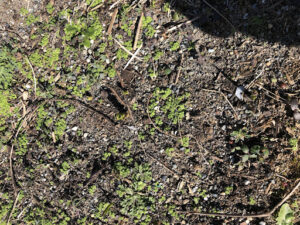
Collaborators for the Burke Meadow project began to consider strategies for responding to this challenge. These collaborators – students and staff from the Burke Museum, the museum’s Native American Advisory Board and associated tribal elders, the Department of Landscape Architecture, and UW Grounds – have been collaborating on the Burke Meadow project since Fall of 2019. The consortium has made mistakes and learned lessons that have strengthened their relationships personally and professionally. This history of collaboration provided a strong foundation for this latest project.
The collaborators agreed on the idea of weaving a structure around plots in the meadow to protect camas from grazing rabbits. Chair of the Department of Landscape Architecture Ken Yocom suggested holding a design workshop to complete this project, and Burke Museum Director of DEAI & Decolonization Polly Olsen (Yakama) tapped Yakama and Paiute weavers Val and Gil Calac to lead that workshop. Collaborators on the Burke Meadow project – students and staff from the Landscape Architecture departments, the Burke Museum, and the Burke Herbarium – intended to use material present on campus to create these baskets. UW Grounds Gardener Lead Steve Kryszko suggested a synergistic opportunity – students could harvest willow from a stand of bushes in front of the E12 parking lot which UW Grounds wanted to remove due to safety concerns from staff members who parked in the lot. In late February and early March, students from the Landscape Architecture department joined the Indigenous Food Knowledge Family, students learning traditional knowledge skills with a focus on food practices, and Decolonization Coordinator Aaron McCanna (Yup’ik) in harvesting willow stems for the weaving project. Students collected well over 900 willow stems for the weaving project. Material for stakes and additional stems came from unclaimed dogwood bushes originally intended as donations to the Woodland Park Zoo.
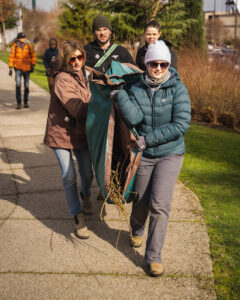
The students working on the project, aided by Polly Olsen and Aaron McCanna, began the weaving project on March 3rd. The collaborators applied creativity, quick thinking, and traditional knowledge to complete four panels for one out of the three planned baskets on the first weekend. This first basket was installed on March 5th and protects the bunch of camas nearest to the path that bisects the meadow.
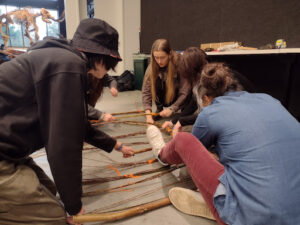
The following weekend, Val and Gil Calac arrived to provide guidance to the collaborators, who wove the last two baskets with much more efficiency thanks to their skill gained from the first basket. Burke Museum staff and students from an archaeology class joined the basket-weaving project, and together the collaborators wove the other two baskets and installed them in the meadow on March 10th.
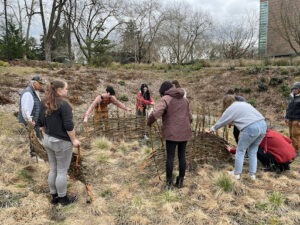
Today, these baskets protect camas from eager rabbits, as intended. There has been no breaching of the baskets or further browsing of camas within the baskets, and camas within the baskets look healthier than the unprotected camas. These baskets are an inspiring example of local low-carbon material use. They also demonstrate the beauty and efficacy of Indigenous knowledge and interdisciplinary collaboration – if you visit the Burke Museum, feel free to stop by the meadow and observe them!
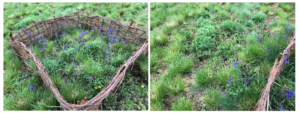
Written by Miguel Symonds Orr, student researcher